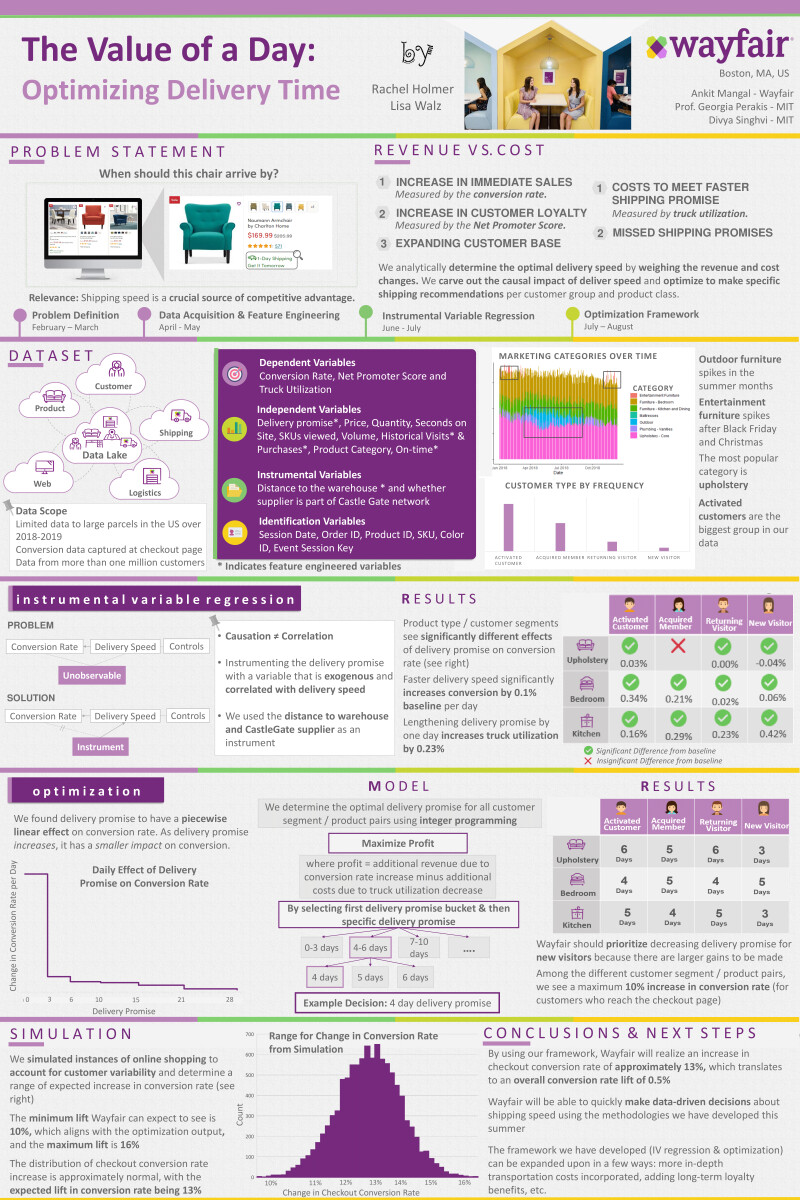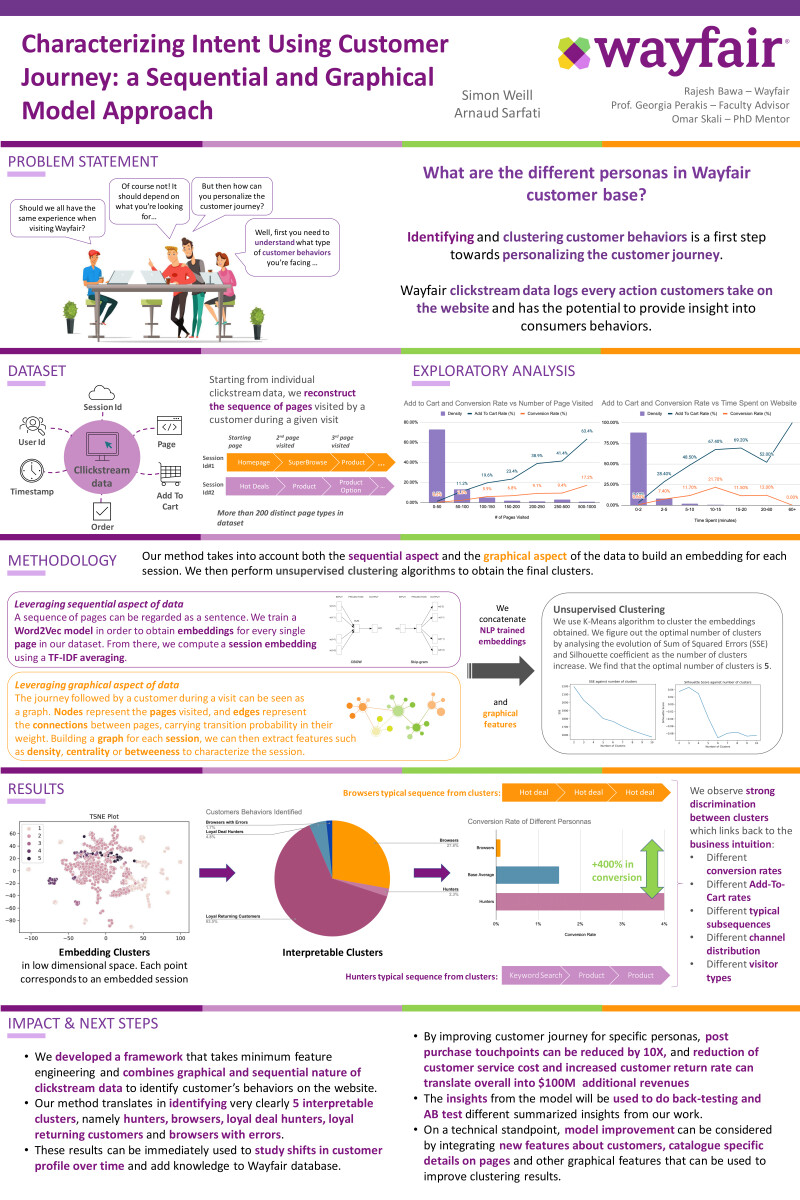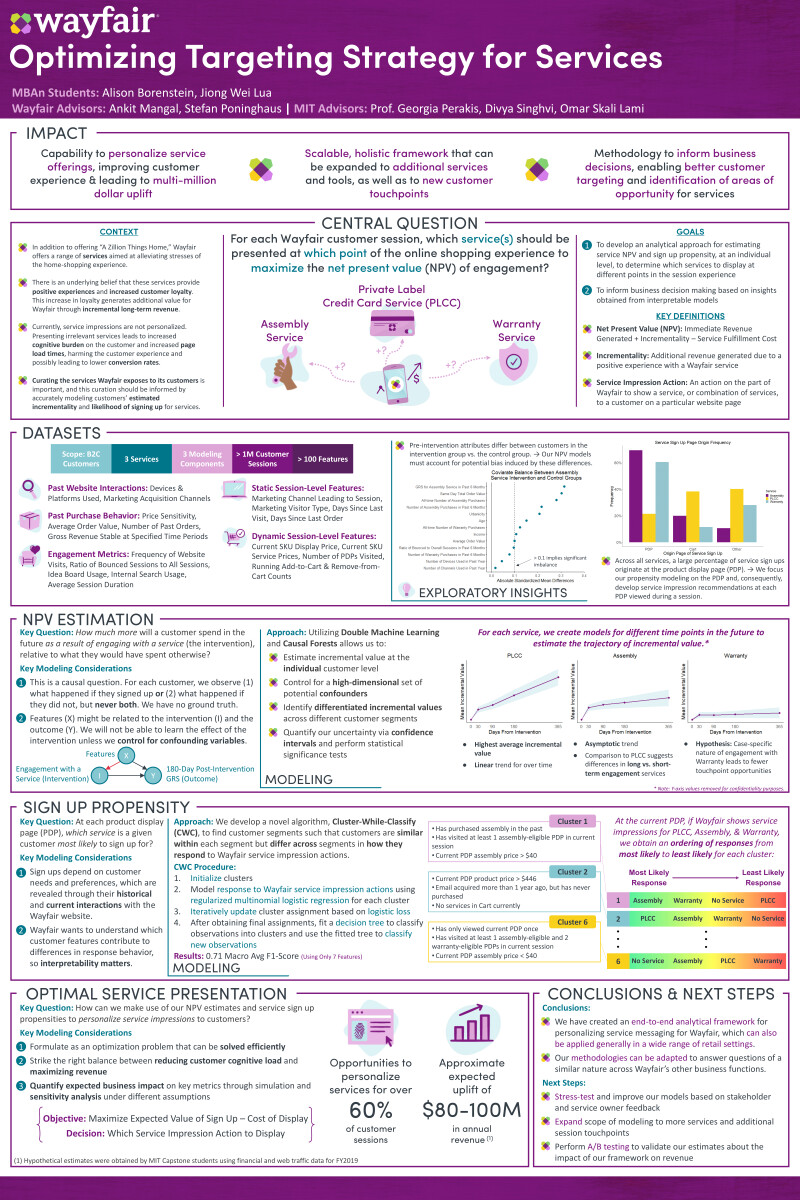Every day, Wayfair customers sift through more than 33 million items. Their goal? To find the perfect items to create a home they love. It’s not a grueling and stressful search, and their success isn’t the result of good luck. It’s the byproduct of a technology team committed to enhancing the customer experience through cutting-edge solutions.
The technology team is the DNA of Wayfair, and we are always looking to bring people with different perspectives and backgrounds to the table to help fuel our drive for innovation. This also includes people from outside of our organization, which is why Wayfair serves as a Capstone host with academic institutions like MIT.
The MIT name is synonymous with innovation, and for the past three years, we have worked with the MIT Sloan School of Management’s Master of Business Analytics (MBAn) Capstone Project, which is a requirement of the business school’s degree program. The 7-month-long team project gives students an opportunity to test and practice their data science “know-how” by applying their skills to real-world business problems with industry practitioners such as Wayfair.
This is a classic win-win scenario. Located right in the backyard of our Boston headquarters, MIT Sloan is helping to prepare the next generation of data scientists. Now through this incredibly strong program, these MBAn students have had the opportunity to produce truly cutting-edge solutions that tackle some of our company’s most pressing needs.
As for the students, they gain hands-on, real-world experience helping iconic brands evolve. They also gain a behind-the-scenes look into Data Science at Wayfair and potential post-graduate opportunities where they can continue their career growth.
The Capstone Project Program
So how does it work? For the past three years, I have worked with teams across Wayfair to identify the top five problems facing the company. A common theme has emerged—they can all be solved through data science. Each year we have narrowed this down to one problem.
When Capstone Projects kick off in January, student teams are matched with host companies and assigned dedicated faculty advisors. From that point forward, the students roll up their sleeves and get to work creating, iterating, and designing solutions. From February through May, students work on the projects from the MIT Sloan campus. During this time, they meet regularly with their faculty advisor and host organization to create a bold solution to the challenge. With the arrival of summer, the program shifts, and students begin traveling to the host organization for a full-time summer internship that culminates in August. That’s when the students submit their final report and presentation and earn their formal degree.
The Wayfair Projects
As we just kicked off our fourth year as a Capstone Project host, I thought this would be a great time to look back at the projects from our first three years and to preview the challenge that the new team of students are tackling in this fourth iteration.



Year One
Project: Faster or Slower – the Value of a Day
In year one, Wayfair’s Algorithms and Analytics department wanted to understand the relationship between demand (sales) and cost. Specifically, what would happen if we were to speed up or slow down shipments across the various categories of goods on Wayfair.com. Would this cause a lift in revenues or impact truck utilization rates? Would scenarios differ from one product category to the next?
The Solution
The students simulated instances of online shopping to account for customer variability and determined a range of expected increases in conversion rates. According to the results, the framework would allow Wayfair to realize an increase in checkout conversion rate of approximately 13%. You can see the entire project framework in the Optimize Targeting Poster. This would translate to an overall conversion rate lift of 0.5 percent. I’m proud to say this was named the best project by the MBAn program in 2019.
Year Two
Project: ‘Cohesion: Optimizing Targeting Strategy for our Services’
In year two, the focus shifted to Wayfair services. These are vital to delivering customers an anxiety-free home shopping experience. Examples include our Assembly and Installation services for large items, Interior Design Services, Financing, Warranty, and more. Here the team was looking to understand which services were most relevant to a customer at any point in time and how much profit is made when a customer opts-in. This includes the amount customers would pay and the “halo” effect – how much incremental profit is made by selling more items due to the great experience provided under that service.
The Solution:
The team created an end-to-end analytical framework to determine which services to display to each customer at different points in the session experience. Through this work, they found opportunities to personalize services for over 60 percent of customer sessions, which could generate anywhere from $80M to $100M in additional revenue for Wayfair. This framework is described in the Optimize Targeting Poster. The work was also featured in a journal paper that ran in INFORMS, a publication by the Institute for Operations Research and the Management Sciences.
Year Three
Project: Customer Journey Optimization
In year three, the Wayfair Storefront team examined the customer journey across the business’s multiple touchpoints. The goal was to better understand their needs and pain points using a Customer Journey Optimization framework. There were a couple of requirements. First, the framework needed to identify the different customer personas and define the optimal path to purchase tailored for each. Next, it needed to glean guidance on which features and elements (visual filters, category pages, reviews, product imagery, etc.) drive engagement and those that require further development.
The Solution:
The student team developed a framework that takes minimum feature engineering and combines the graphical and sequential nature of clickstream data to identify customers’ behaviors on the website. Through their work, which you can see in the poster, they identified five clusters—hunters, browsers, loyal deal hunters, loyal returning customers, and browsers with errors. From there, the team found that by improving the customer journey for specific personas, Wayfair could reduce post-purchase touchpoints by 10X. By decreasing the customer service cost and increasing the customer return rate, Wayfair could realize $100M in additional revenues.
What’s Next?
Since we began hosting the MIT Sloan Masters of Business Analytics Capstone Project, the impact student teams have had on our business has been significant, as you can see from some of the results I touched on earlier. The projects have also had a positive effect on the students. This is why Wayfair signed up for another four years, which officially kicked off last month. The focus of the 2022 campaign is to figure out how we can better optimize ads on the website. It’s an exciting task, and as always, I can’t wait to see where their latest journey ends. Stay tuned!
